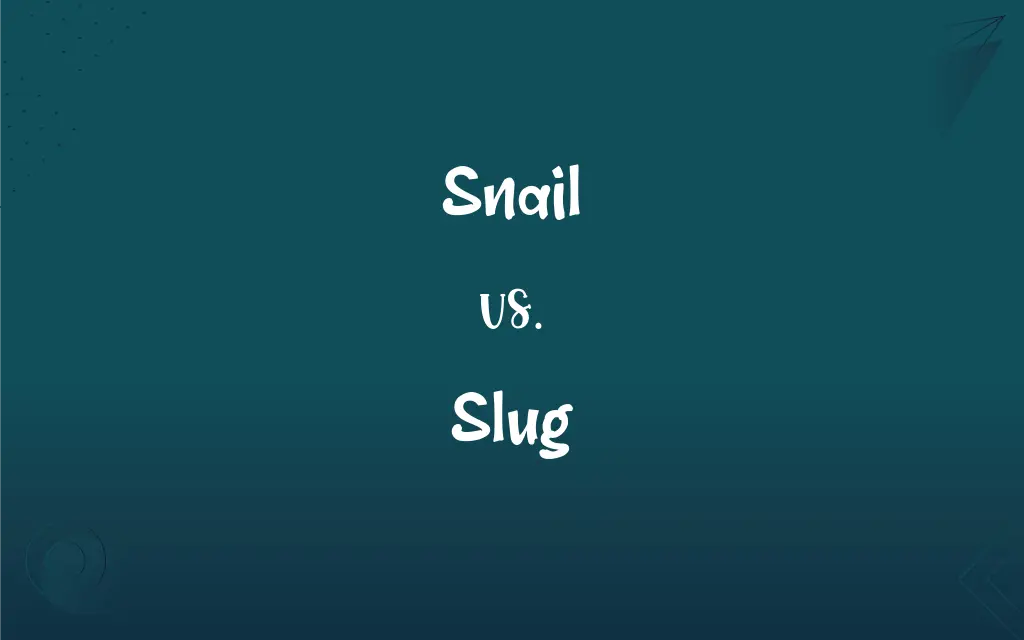Snail vs. Slug: What's the Difference?
Edited by Aimie Carlson || By Harlon Moss || Updated on June 30, 2024
Snails are gastropods with a coiled shell to retreat into, while slugs lack this noticeable shell, appearing more "naked." Both are mollusks, moving via a muscular foot and leaving a slimy trail.

Key Differences
Snails and slugs both belong to the gastropod class, renowned for their slow movement and distinctive slimy trails. Snails carry a notable shell on their back which can serve as protection and retain moisture. Slugs, however, are devoid of this shell, giving them a more vulnerable and exposed appearance.
Both snails and slugs possess a unique locomotion, moving on a singular muscular foot and secreting a slimy mucus. While snails generally tend to be somewhat restricted due to their shells, limiting their access to certain spaces, slugs have more flexibility and can squeeze through tighter areas due to their lack of a hard, rigid external structure.
In terms of habitat, snails often favor environments where they can access calcium for their shell. Slugs can tolerate a wider range of environments because they are not bound by the necessity to derive shell-building materials from their surroundings. Both snails and slugs are mostly found in moist environments due to their need to preserve body moisture.
The diets of snails and slugs have differences, despite both being predominantly herbivorous. Snails often consume algae, plants, and even chalk for calcium, while slugs might display more opportunistic feeding, even indulging in carrion or food scraps, given their lack of a shell and an associated need for calcium.
Reproduction in both snails and slugs typically involves a fascinating process since most species are hermaphroditic, possessing both male and female reproductive organs. Both engage in a peculiar mating dance, but the snail’s shell often necessitates a more complex and at times cumbersome copulation process as compared to the generally more straightforward mating of slugs.
ADVERTISEMENT
Comparison Chart
Physical Appearance
Has a distinct, typically coiled shell
Lacks a shell, appears more elongated
Movement and Access
Somewhat restricted by shell
Can access tighter spaces easily
Habitat Requirements
Requires access to calcium for shell
Can live in varied habitats
Dietary Preferences
Consumes algae, plants, and chalk
More opportunistic, can consume carrion
Reproduction
Mating can be cumbersome due to shell
Generally has more straightforward mating
ADVERTISEMENT
Snail and Slug Definitions
Snail
A snail is a slow-moving mollusk with a coiled shell.
The snail carried its home on its back, traversing the garden at a leisurely pace.
Slug
A slug is a gastropod mollusk without a shell, known for its slow movement.
The slug slowly made its way across the damp forest floor.
Snail
Snails possess a radula, a tongue-like organ used for feeding.
Using its radula, the snail scraped algae off the aquarium glass, slowly cleaning it.
Slug
Slugs navigate through their environments using a single, muscular foot.
The slug moved gracefully over the rock, its foot contracting and expanding.
Snail
Snails use a muscular foot for locomotion and leave a characteristic slimy trail.
As it moved across the patio, the snail left a glistening trail behind it.
Slug
Slugs can be found in various habitats, including forests, gardens, and even marine environments.
The bioluminescent sea slug fascinated the marine biologists with its beautiful glow.
Snail
In culinary contexts, snails, especially certain species, are eaten as escargot.
The French restaurant offered garlic butter snails as an appetizer.
Slug
Slugs are notorious among gardeners for damaging plants by eating their leaves.
A gardener might use beer traps to prevent slugs from ruining the lettuce.
Snail
Snails can both harm and benefit environments, eating vegetation and providing nutrient recycling.
The gardener lamented the snails in the vegetable patch, as they nibbled on the lettuce.
Slug
Some species of slugs are able to produce a noxious secretion when threatened.
When threatened by a predator, the slug secreted a sticky substance.
Snail
Any of numerous aquatic or terrestrial gastropod mollusks that typically have a spirally coiled shell, retractile foot, and distinct head.
Slug
A round bullet larger than buckshot.
Snail
A slow-moving, lazy, or sluggish person.
Slug
A shot of liquor.
FAQs
What class do snails and slugs belong to?
Gastropoda.
Can snails and slugs live in both land and water environments?
Yes, various species adapt to terrestrial, freshwater, and marine habitats.
What do snails and slugs eat?
They generally eat plants, fungi, and algae, but some species can be opportunistic feeders.
Is it true that snails sleep for a long time?
Some species of snails can sleep for several years under certain conditions.
How do snails and slugs move?
They use a muscular foot and secrete mucus to move.
How do slugs and snails sense their environment?
They use a combination of tentacles, taste, and tactile sensors.
Are slugs and snails harmful to garden plants?
Yes, they can damage garden plants by eating leaves and stems.
How can I prevent slugs from eating my garden plants?
Utilizing barriers, traps, and slug-resistant plants can help.
What is the lifespan of a snail?
It varies by species, ranging from a few years to over a decade in some cases.
Do snails and slugs have enemies?
Yes, they have predators like birds, mammals, reptiles, and certain insects.
Do slugs and snails have eyes?
Yes, they have eye spots located on the tips of their upper tentacles.
Can snails and slugs regenerate their bodies?
To an extent, such as regrowing tentacles, but not entire bodies.
Are there slug and snail species that are endangered?
Yes, some species are considered threatened or endangered.
Do both snails and slugs have shells?
Snails have shells, while slugs typically do not.
Are slugs and snails edible?
Yes, certain species are edible and are even considered delicacies.
How do snails and slugs reproduce?
Many species are hermaphroditic and can produce both eggs and sperm.
What is the function of the slimy trail of snails and slugs?
It aids in movement, reduces friction, and helps retain moisture.
Do snails and slugs hibernate?
Yes, many species go into a dormant state during adverse conditions.
How do snails produce their shells?
They secrete calcium carbonate, shaping and hardening it into a protective shell.
Can slugs and snails transmit diseases?
Some can be vectors for parasitic organisms that may be harmful.
About Author
Written by
Harlon MossHarlon is a seasoned quality moderator and accomplished content writer for Difference Wiki. An alumnus of the prestigious University of California, he earned his degree in Computer Science. Leveraging his academic background, Harlon brings a meticulous and informed perspective to his work, ensuring content accuracy and excellence.
Edited by
Aimie CarlsonAimie Carlson, holding a master's degree in English literature, is a fervent English language enthusiast. She lends her writing talents to Difference Wiki, a prominent website that specializes in comparisons, offering readers insightful analyses that both captivate and inform.































































